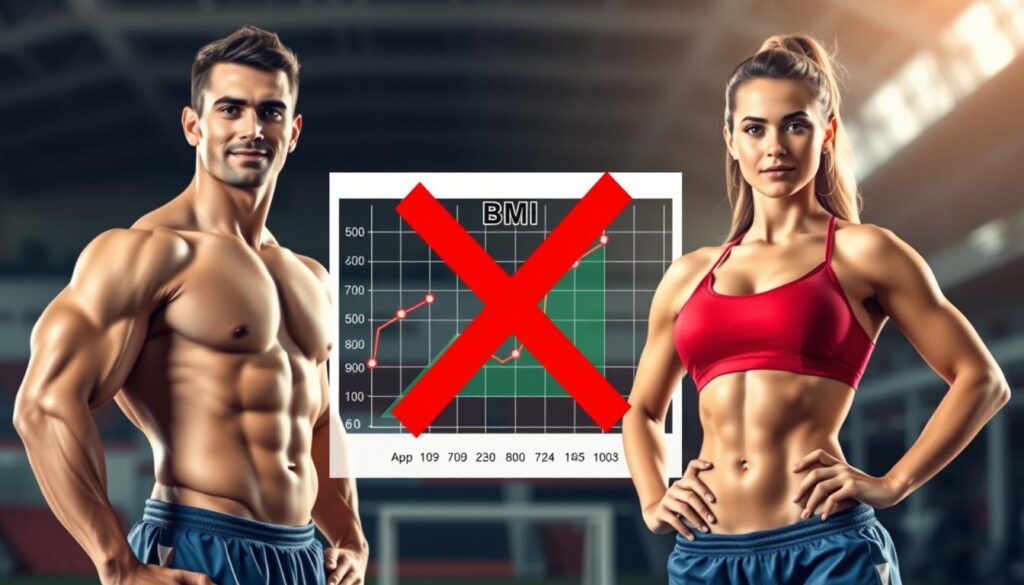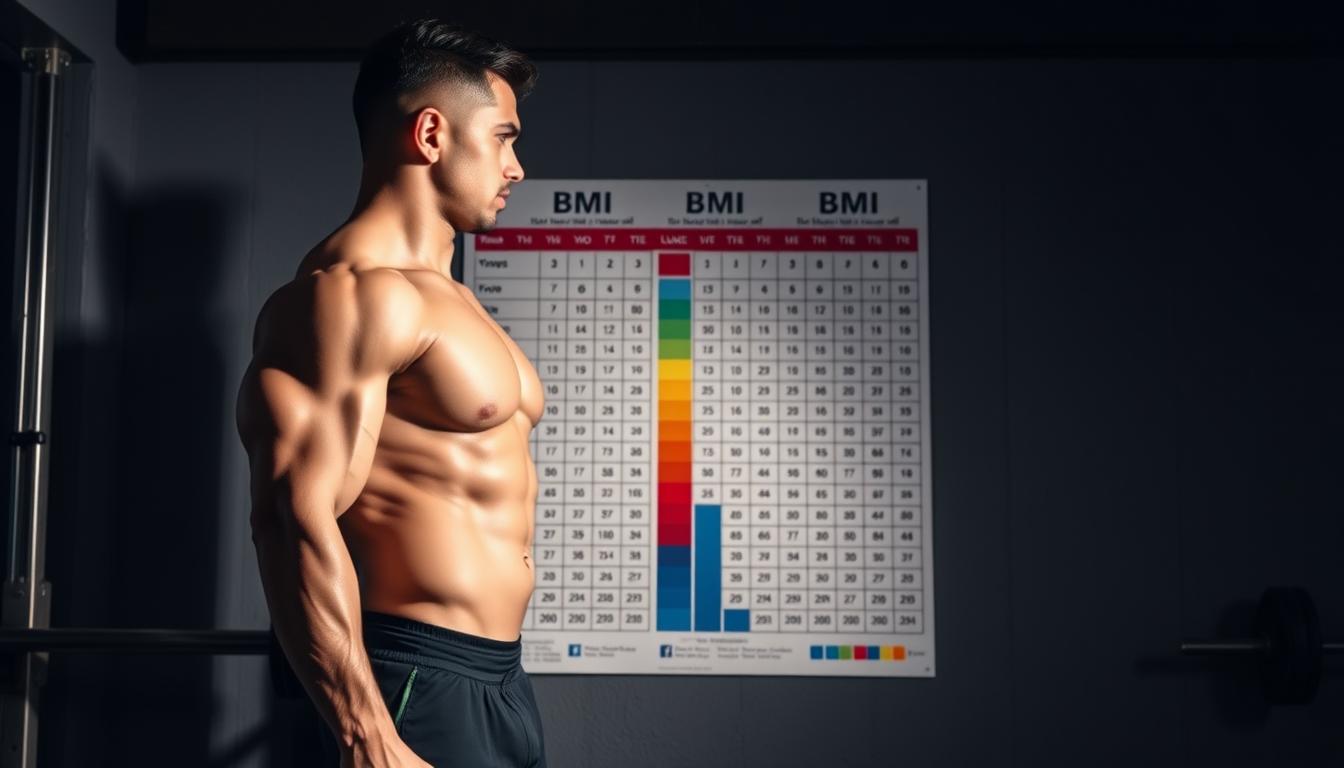For years, Body Mass Index (BMI) has been used to check weight status. But, does it really show the health of athletes? Athletes with lots of muscle often get labeled as overweight or obese by BMI, even if they have very little body fat.
We rely on BMI, but it ignores muscle mass, bone density, and body composition. For example, a pro football player might have a high BMI because of muscle, not fat. This makes us wonder if BMI is right for athletes. To truly understand an athlete’s health, we need other ways to measure. You can check your body composition with our BMI calculator for men, a fast way to see your body’s makeup.
Key Takeaways
- Athletes may be misclassified as overweight due to high muscle mass.
- BMI doesn’t account for body composition or muscle mass.
- Alternative metrics are needed to accurately assess athlete health.
- BMI has limitations for certain populations, including athletes.
- Using BMI alone can lead to inaccurate health assessments.
Understanding BMI and Its Limitations
In the world of sports, BMI’s flaws are clear, mainly for athletes with lots of muscle. The Body Mass Index (BMI) has been used for years to sort people by weight. But, it’s not perfect for athletes.
“BMI is a simple, yet flawed, measure that fails to account for the nuances of body composition,” says a renowned expert in the field of sports medicine. This oversight can lead to misleading classifications, as athletes with lots of muscle might be seen as overweight or obese.
Definition of BMI
BMI is found by dividing your weight in kilograms by your height in meters squared. It was first used by Adolphe Quetelet in the 1830s and became popular in 1972 by Ancel Keys. But, it’s been criticized for not telling the difference between lean and fat mass, which is key for athletes.

Historical Context of BMI
BMI was made to be a simple way to check weight status for large groups. It was not meant for individual checks, like for athletes. But, over time, it’s been used more widely, ignoring these differences.
General Population vs. Athletes
When we compare BMI in the general population to athletes, big differences show up. Athletes have more lean body mass than non-athletes. So, using BMI for athletes can be wrong.
For example, many athletes might be seen as overweight or obese by BMI, even if they have very little body fat. Studies have found that BMI often overestimates body fat in muscular people. This can lead to wrong health checks for athletes.
To really understand an athlete’s health, we need to look beyond BMI. We should use more detailed measures that consider body composition. This way, athletes get health checks that are accurate and relevant.
The Composition of Athletic Bodies
The athletic body is complex, with muscle and fat distribution key to performance and health. It’s important to understand body composition to evaluate athletes well.
Muscle vs. Fat: A Key Distinction
Athletes usually have more muscle than the average person. This is crucial because muscle and fat have different densities. This can affect BMI readings.
Athletes with a lot of muscle may be seen as overweight or obese by BMI, even if they have low body fat percentages. BMI only looks at weight and height, not body composition.
Take LeBron James as an example. He has a high muscle mass percentage. His BMI might say he’s overweight, but he actually has a low body fat percentage. This shows his true health and fitness.

How Body Composition Affects BMI
Body composition greatly influences an athlete’s BMI. Muscle is denser than fat, so athletes with more muscle will weigh more. This can lead to a higher BMI, but doesn’t mean they’re unhealthy or overweight.
Research shows BMI can misclassify athletes. For example, a study in the Journal of Strength and Conditioning Research found many athletes were wrongly labeled as overweight or obese by BMI alone.
| Athlete | BMI | Body Fat Percentage |
|---|---|---|
| LeBron James | 27.3 | 6-8% |
| Serena Williams | 26.4 | 12-14% |
| Usain Bolt | 25.8 | 6-8% |
Role of Genetics in Athletic Physique
Genetics also shape an athlete’s physique. They can affect muscle distribution, body shape, and overall body composition. As
“Genetics play a significant role in an athlete’s natural ability and body composition, which can affect their performance in various sports.”
Knowing the genetic aspect helps tailor training and health assessments to each athlete’s needs.
For example, some athletes are naturally better at sprinting due to their muscle fibers. Others may have a natural endurance advantage.
The Impact of BMI on Athletic Performance
Using BMI on athletes shows a big problem: it can’t tell muscle from fat. This mistake can change how athletes are seen and treated.
Misleading Health Assessments
Using BMI to check athletes’ health can lead to wrong conclusions. Athletes with lots of muscle might seem overweight or obese, even if they’re very fit. A study says, “the BMI is not a reliable indicator of health risks for athletes because it does not differentiate between lean body mass and body fat.”
This mistake can cause athletes to worry too much or get bad health advice. For example, a football player with a high BMI from muscle might be told to lose weight. This could hurt their game.
Consequences on Training and Competitions
When BMI gets athletes wrong, it can mess up their training and competitions. Athletes seen as overweight or obese might get bad training advice or be left out of competitions.
A study on rugby players found that those with higher BMIs weren’t always at risk. But, they were often ranked lower because their muscle was seen as fat.
Examples of Athletes Misclassified by BMI
Many famous athletes have been wrongly judged by BMI. For example, LeBron James, a top basketball player, is seen as overweight by BMI. But, his body fat is healthy, and he’s very fit.
Tom Brady is another example. He’s known for being in great shape, but his BMI is high because of his muscle. These cases show we need better ways to check athletes’ health.

In short, BMI’s effect on athletes is big. It leads to wrong health checks and affects training and games. By knowing its limits and looking at other ways to measure, we can better judge athletes’ health.
Alternative Metrics for Evaluating Athletes
Traditional metrics like BMI often don’t work well for athletes. They have more muscle than the average person, which can make BMI scores misleading. So, we need other ways to measure their health and performance.
Body Fat Percentage
Body fat percentage is a great alternative. It looks at how much body fat you have, unlike BMI which just looks at weight and height. This is really helpful for athletes because it shows their body composition more clearly. For example, a study on Medical News Today shows how important body fat percentage is for health risks.
Waist-to-Hip Ratio
The waist-to-hip ratio is another useful metric. It shows how body fat is spread out. For athletes, keeping this ratio in check is key for both health and performance.
Functional Movement Screens
Functional Movement Screens (FMS) are becoming more popular too. They check how well athletes move, spotting injury risks and areas to get better. FMS looks at how well you move, which is important for staying healthy and performing well.
Let’s look at how these metrics compare:
| Metric | Description | Relevance to Athletes |
|---|---|---|
| Body Fat Percentage | Direct measurement of body fat proportion | Provides a clear picture of body composition |
| Waist-to-Hip Ratio | Measures body fat distribution | Indicates health risks associated with central obesity |
| Functional Movement Screens | Evaluates movement patterns and quality | Identifies injury risks and areas for improvement |
In summary, metrics like body fat percentage, waist-to-hip ratio, and functional movement screens give a better look at athletes’ health and performance. Using these metrics helps us understand athletes’ needs better. This way, we can make training programs that improve their performance and keep them healthy.
The Importance of Individualized Assessment
To truly understand an athlete’s health and performance, we need a custom approach. This method goes beyond simple tools like BMI, which often misjudge athletes due to muscle mass.
Athletes come in all shapes and sizes, shaped by their sport, training, and genes. So, their health checks should be made just for them.
Tailoring Health Evaluations
Health checks for athletes should match their sport, training, and goals. For example, a bodybuilder and a long-distance runner need different body types. Their assessments should show this.
Using body fat percentage, waist-to-hip ratio, and functional movement screens gives a full picture of an athlete’s health and fitness.
| Athlete Type | Key Assessment Metrics | Performance Goals |
|---|---|---|
| Bodybuilder | Body Fat Percentage, Muscle Mass | Maximize Muscle Hypertrophy |
| Long-Distance Runner | Cardiovascular Endurance, Body Fat Percentage | Enhance Endurance and Speed |
| Sprinter | Power Output, Muscle Strength | Maximize Speed and Acceleration |
Understanding Unique Athletic Needs
Knowing what each athlete needs is key to good training and nutrition plans. Their body and mind can greatly affect how they perform and stay healthy.
For instance, athletes with more muscle might need different food plans than those with less. Athletes with injuries might need special rehab programs.
Incorporating Professional Guidance
Getting advice from experts is crucial for athletes. Sports dietitians, physiotherapists, and sports scientists offer valuable insights.
They help athletes deal with their sport’s challenges. They give personalized advice on training, eating, and recovery to boost performance and lower injury risk.
By focusing on individual needs, athletes get more accurate health checks. This leads to better performance and fewer health problems.
Conclusion: Rethinking BMI for Athletes
BMI has big problems when used for athletes. It can’t tell the difference between muscle and fat. This mistake can lead to wrong health checks and hurt training and competitions.
It’s key to check athletes’ health in a full way. We should look at body fat, waist-to-hip ratio, and how well they move. This gives a true picture of their health and skills.
Shifting Perception and Practice
We need to change how we see health checks for athletes. Moving past BMI and using more detailed methods helps athletes reach their best.
Enhancing Athlete Wellness
Full health checks offer custom advice for each athlete. This boosts their overall health and performance.
Future of Athletic Health Evaluation
We should keep working on better health checks for athletes. This ensures athletes get the best support for their health and success.


